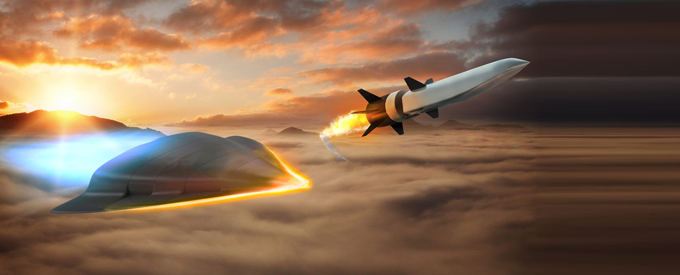2020-06-14
Developing Hypersonics to Defend Future Threats
When U.S. intelligence officials consider the threats of the future, many are thinking of a new type of missile so fast it can travel from New York to Los Angeles in 39 minutes flat. At that speed, such a threat would be extremely difficult to stop – a worrying scenario.
Moreover, the concern is real as Russia and China both claim to have tested hypersonic systems. Hypersonic weapons can travel at five times the speed of sound (Mach 5 and faster), covering vast distances in minutes.
According to the Pentagon’s weapons research division, China has tested more hypersonic weapons than the U.S. in the last decade which, compared to current military systems, offer longer ranges with shorter response times and enhanced effectiveness. As the capabilities of adversaries advance, development of these systems could provide significant payoff for future offensive strike operations.
Raytheon Technologies now has a US$63 million contract with the U.S. Defence Advanced Research Projects Agency to develop highly manoeuvrable hypersonic missiles designed to fly aerodynamically in the upper atmosphere at sustained speeds above Mach 5. These missiles have five times the speed of sound, manoeuvring at altitudes that avoid long-range radars.
Built to carry nuclear and conventional warheads, although these traditional ballistic missiles travel at hypersonic speeds, reaching outer space if desired, they can’t manoeuvre. The latest class of hypersonic missiles will be smaller, guided and designed to carry conventional explosives for time-sensitive, rapid response within theatre operations.
Long-range Challenging to Intercept
Launched from the ground, aircraft, surface ships or submarines, hypersonic missiles strike time-critical targets much quicker and at a longer range than today’s conventional weapons.
“Hypersonic weapons can be more survivable because of the extreme speed and high altitude. They would be hard to stop,” said J.R. Smith, director of Advanced Land Warfare Systems at Raytheon Missiles & Defence, a company of Raytheon Technologies.
Advanced Manufacturing
As they accelerate through the atmosphere, fast-flying vehicles require unique materials to withstand blazing temperatures from the friction produced. Developing structures that can withstand furnace-like temperatures at such high speeds is a technical challenge, especially for the leading edges that bear the brunt of the heat.
The key is to develop scalable materials architectures that enable mass transport to spread and reject heat, so recent years have seen advanced manufacturing emerge in the thermal engineering sector to enable the design and fabrication of very complex architectures that were not possible in the past. Now Raytheon Technologies is using advanced materials to build heat shields that cocoon and shield the electronics inside the missile.
Hypersonics must also be aerodynamically manoeuvrable, posing challenges to thermodynamics, complex geometries, materials and manufacturing. The most effective shapes for hypersonic systems are highly complex and quite different from conventional aircraft or missiles.
Those shapes are now being developed for the first time and Raytheon Technologies has made significant investments in advanced design manufacturing facilities, establishing its Immersive Design Centre as a virtual 3-D environment for collaborative engineering and design. At the company’s facilities in Tucson, Arizona, engineers are working to overcome the challenges posed by the combination of speed and the extreme environmental conditions in which the missiles must operate.
Hypersonic Guidance Challenges
The challenge of guiding a hypersonic vehicle to its target is that the missile heats up as it accelerates through the atmosphere. Its sensitive inner electronics must be protected from blazing temperatures without adding extra weight and so impairing speed, range and guidance.
There are two approaches to solving the hypersonic challenge, known as scramjet and boost glide.
The power of the air-breathing scramjet relies on high speed where more air and fuel are pushed into the engine as it accelerates, allowing it to accelerate to hypersonic speeds. According to the DARPA website, for a tactical-range boost glide weapon to achieve hypersonic speeds, “a rocket accelerates its payload to high speeds.
The payload then separates from the rocket and glides unpowered to its destination.”
The future for Raytheon Technologies lies in a number of futuristic technologies promising the next giant leap in counter-hypersonics and hypersonic vehicles that may not completely replace today’s weapons, but will complement the many sub- and supersonic missiles already in the U.S. military’s inventory. Meanwhile, hypersonic missiles are being developed under multiple U.S. government contracts, including an investment from Raytheon Technologies itself.


No Comments